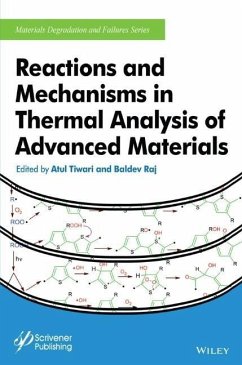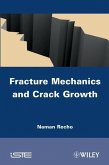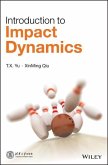Atul Tiwari, Baldev Raj
Reactions and Mechanisms in Thermal Analysis of Advanced Materials
Herausgeber: Tiwari, Atul; Raj, Baldev
Atul Tiwari, Baldev Raj
Reactions and Mechanisms in Thermal Analysis of Advanced Materials
Herausgeber: Tiwari, Atul; Raj, Baldev
- Gebundenes Buch
- Merkliste
- Auf die Merkliste
- Bewerten Bewerten
- Teilen
- Produkt teilen
- Produkterinnerung
- Produkterinnerung
Strong bonds form stronger materials. For this reason, the investigation on thermal degradation of materials is a significantly important area in research and development activities. The analysis of thermal stability can be used to assess the behavior of materials in the aggressive environmental conditions, which in turn provides valuable information about the service life span of the materiel.
Unlike other books published so far that have focused on either the fundamentals of thermal analysis or the degradation pattern of the materials, this book is specifically on the mechanism of…mehr
Andere Kunden interessierten sich auch für
![Electromagneto-Mechanics of Material Systems and Structures Electromagneto-Mechanics of Material Systems and Structures]() Yasuhide ShindoElectromagneto-Mechanics of Material Systems and Structures189,99 €
Yasuhide ShindoElectromagneto-Mechanics of Material Systems and Structures189,99 €![Fatigue of Materials and Structures Fatigue of Materials and Structures]() Fatigue of Materials and Structures201,99 €
Fatigue of Materials and Structures201,99 €![Residual Stress Residual Stress]() Residual Stress175,99 €
Residual Stress175,99 €![Particulate Emissions from Vehicles Particulate Emissions from Vehicles]() Peter EastwoodParticulate Emissions from Vehicles201,99 €
Peter EastwoodParticulate Emissions from Vehicles201,99 €![Seismic Vulnerability of Structures Seismic Vulnerability of Structures]() Philippe GueguenSeismic Vulnerability of Structures190,99 €
Philippe GueguenSeismic Vulnerability of Structures190,99 €![Fracture Mechanics and Crack Growth Fracture Mechanics and Crack Growth]() Naman RechoFracture Mechanics and Crack Growth318,99 €
Naman RechoFracture Mechanics and Crack Growth318,99 €![Introduction to Impact Dynamics Introduction to Impact Dynamics]() T. X. YuIntroduction to Impact Dynamics146,99 €
T. X. YuIntroduction to Impact Dynamics146,99 €-
-
-
Strong bonds form stronger materials. For this reason, the investigation on thermal degradation of materials is a significantly important area in research and development activities. The analysis of thermal stability can be used to assess the behavior of materials in the aggressive environmental conditions, which in turn provides valuable information about the service life span of the materiel.
Unlike other books published so far that have focused on either the fundamentals of thermal analysis or the degradation pattern of the materials, this book is specifically on the mechanism of degradation of materials.
The mechanism of rapturing of chemical bonds as a result of exposure to high-temperature environment is difficult to study and resulting mechanistic pathway hard to establish. Limited information is available on this subject in the published literatures and difficult to excavate.
Chapters in this book are contributed by the experts working on thermal degradation and analysis of the wide variety of advanced and traditional materials. Each chapter discusses the material, its possible application, behavior of chemical entities when exposed to high-temperature environment and mode and the mechanistic route of its decomposition. Such information is crucial while selecting the chemical ingredients during the synthesis or development of new materials technology.
Hinweis: Dieser Artikel kann nur an eine deutsche Lieferadresse ausgeliefert werden.
Unlike other books published so far that have focused on either the fundamentals of thermal analysis or the degradation pattern of the materials, this book is specifically on the mechanism of degradation of materials.
The mechanism of rapturing of chemical bonds as a result of exposure to high-temperature environment is difficult to study and resulting mechanistic pathway hard to establish. Limited information is available on this subject in the published literatures and difficult to excavate.
Chapters in this book are contributed by the experts working on thermal degradation and analysis of the wide variety of advanced and traditional materials. Each chapter discusses the material, its possible application, behavior of chemical entities when exposed to high-temperature environment and mode and the mechanistic route of its decomposition. Such information is crucial while selecting the chemical ingredients during the synthesis or development of new materials technology.
Hinweis: Dieser Artikel kann nur an eine deutsche Lieferadresse ausgeliefert werden.
Produktdetails
- Produktdetails
- Materials Degradation and Failure
- Verlag: Wiley & Sons
- 1. Auflage
- Seitenzahl: 616
- Erscheinungstermin: 3. August 2015
- Englisch
- Abmessung: 257mm x 183mm x 36mm
- Gewicht: 1225g
- ISBN-13: 9781119117575
- ISBN-10: 1119117577
- Artikelnr.: 42834113
- Herstellerkennzeichnung
- Libri GmbH
- Europaallee 1
- 36244 Bad Hersfeld
- gpsr@libri.de
- Materials Degradation and Failure
- Verlag: Wiley & Sons
- 1. Auflage
- Seitenzahl: 616
- Erscheinungstermin: 3. August 2015
- Englisch
- Abmessung: 257mm x 183mm x 36mm
- Gewicht: 1225g
- ISBN-13: 9781119117575
- ISBN-10: 1119117577
- Artikelnr.: 42834113
- Herstellerkennzeichnung
- Libri GmbH
- Europaallee 1
- 36244 Bad Hersfeld
- gpsr@libri.de
Dr. Atul Tiwari is a research faculty member in the Department of Mechanical Engineering at the University of Hawaii, USA. He has received Ph.D. in Polymer Materials Science along with the bestowed Chartered Chemist and Chartered Scientist status from the Royal Society of Chemistry, UK. Dr. Tiwari is an active member of several professional bodies in the UK, USA, and India. Being an organic chemist and mechanical engineer his research work tends to bridge the gap between the science and engineering. Dr. Tiwari has published more than sixty peer reviewed research publications. His area of research interest includes the development of smart materials including silicones, graphene and bio-inspired biomaterials for industrial applications. Dr. Tiwari zeal to develop new materials and has generated six international patented/pending technologies that have been transferred to the industries. He is an active consultant to renowned companies and acts as associate editor of international journals. Baldev Raj is a distinguished scientist and former director of Indira Gandhi Centre of Atomic Research, India. He has pioneered the application of Non Destructive Testing (NDT) for basic research using acoustic and electromagnetic techniques in a variety of materials and components. He is currently President, International Institute of Welding, President, Indian National Academy of Engineering and President-Research PSG Institutions, Coimbatore. He is a member of the Scientific Advisory Council to Prime Minister, Scientific Advisory Council to Cabinet, Nano Mission Council of India and Apex Advisory Committee, Ministry of Human Resources Development. He is Chairman, Board of Governors, IIT, Gandhinagar & NIT, Puduchery.
Preface xv Part 1: Degradation of Polymers 1 Thermal Stability of Organic Monolayers Covalently Grafted on Silicon Surfaces 3 Florent Yang, Philippe Allongue, Francois Ozanam and Jean-Noel Chazalviel 1.1 Introduction 3 1.2 Alkyl-Grafted Surfaces 8 1.3 Alkoxy-Grafted Surfaces 15 1.4 Surfaces Grafted with Aryl Groups 19 1.5 Surfaces Grafted via Si-N Linkages 22 1.6 Summary 27 References 30 2 Thermal Analysis to Discriminate the Stability of Biomedical Ultrahigh-Molecular-Weight Polyethylenes Formulations 39 Maria Jose Martinez-Morlanes and Francisco Javier Medel 2.1 Introduction 39 2.2 Suitability of TGA Analysis for the Study of Stability of Medical Polyethylene 42 2.3 Activation Energies of Degradation Processes in the Thermal Decomposition of UHMWPE 56 References 58 3 Materials Obtained by Solid-State Thermal Decomposition of Coordination Compounds and Metal-Organic Coordination Polymers 63 Oana Carp 3.1 Introduction 63 3.2 Coordination Compounds and Metal-Organic Coordination Polymers as Precursors of Oxides 65 3.3 Coordination Compounds and Metal-Organic Coordination Polymers as Precursors of Sulfides 72 3.4 Coordination Compounds as Precursors of Composites 74 3.5 Coordination Compounds and Metal-Organic Coordination Polymers as Precursors of New Complexes 74 3.6 Coordination Compounds and Metal-Organic Coordination Polymers as Precursor of Metals 75 3.7 Coordination Compounds as Precursor of Nitrides 76 3.8 Other Materials 77 3.9 Conclusions 77 References 78 4 Methods for Limiting the Flammability of High-Density Polyethylene with Magnesium Hydroxide 85 Joanna Len
a, Maria Sozäska and Henryk Rydarowski 4.1 Introduction 85 4.2 Experimental Part 88 4.3 Results and Discussion 91 4.4 Conclusions 99 References 100 5 Thermal Analysis in the Study of Polymer (Bio)-degradation 103 Joanna Rydz, Marta Musio
and Henryk Janeczek 5.1 Introduction 103 5.2 Differential Scanning Calorimetry 105 5.3 Dynamic Mechanical Analysis 112 5.4 Thermogravimetric Analysis 115 5.5 Conclusions 120 Acknowledgments 121 References 121 6 Thermal and Oxidative Degradation Behavior of Polymers and Nanocomposites 127 Gauri Ramasubramanian and Samy Madbouly 6.1 Introduction 127 6.2 Thermal Degradation 131 6.3 Chemical and Oxidative Degradation 137 6.4 Photo-oxidation 143 6.5 Environmental and Biological Degradation 148 6.6 Degradation of Polymer Nanocomposites 154 6.7 Conclusions 162 References 162 7 Thermal Degradation Effects on Polyurethanes and Their Nanocomposites 165 Ivan Navarro-Baena, Marina P. Arrieta, Alicia Mujica-Garcia, Valentina Sessini, Jose M. Kenny and Laura Peponi 7.1 Introduction 165 7.2 Main Techniques Used for Studying the Thermal Degradation Process 167 7.3 Degradation Mechanisms 169 7.4 Chemical Approaches Used to Improve the Thermal Stability of PU 171 7.5 Thermal Degradation of PU Based on Natural Sources 172 7.6 Nanocomposites 174 7.7 PU Electrospun Fibers 181 7.8 Conclusions 184 References 184 8 Controllable Thermal Degradation of Thermosetting Epoxy Resins 191 Zhonggang Wang 8.1 Introduction 191 8.2 Ester-, Carbamate-, and Carbonate-Linked Reworkable Epoxy Resins 193 8.3 Ether-Linked Reworkable Epoxy Resins 195 8.4 Phosphate- and Phosphite-Linked Reworkable Epoxy Resins 196 8.5 Sulfite-Linked Reworkable Epoxy Resins 204 References 207 9 Mechanism of Thermal Degradation of Vinylidene Chloride Barrier Polymers 209 Bob A. Howell 9.1 Introduction 209 9.2 Discussion 210 9.3 Conclusions 218 References 219 10 Role of Mass Spectrometry in the Elucidation of Thermal Degradation Mechanisms in Polymeric Materials 221 Paola Rizzarelli and Sabrina Carroccio 10.1 Introduction 221 10.2 Thermogravimetry-Mass Spectrometry (TG-MS) 224 10.3 Gas Chromatography-Mass Spectrometry (GC-MS) and Pyrolysis-Gas Chromatography/Mass Spectrometry (Py-GC/MS) 228 10.4 Direct Pyrolysis Mass Spectrometry (DPMS) 237 10.5 Matrix-Assisted Laser Desorption Ionisation Mass Spectrometry (MALDI MS) 242 10.6 Other Mass Spectrometric Techniques 246 10.7 Conclusions 249 References 251 11 The Mechanism of Poly(styrene) Degradation 259 Bob A. Howell 11.1 Introduction 259 11.2 Discussion 260 11.3 Conclusions 266 References 266 12 The Use of Thermal Volatilization Analysis of Polylactic Acid and Its Blends with Starch 269 Derval dos Santos Rosa, Claudio Roberto Passatore, and Jose Ricardo Nunes de Macedo 12.1 Introduction 269 12.2 Use of TVA 271 12.3 TVA as an Analytic Technique 272 12.4 TVA-PLA Investigation 274 12.5 TVA - Thermoplastic Starch 276 12.6 Analyses of TVA - PLA and Their Mixtures with Thermoplastic Starch 280 12.7 Conclusions 282 Acknowledgments 282 References 282 Part 2: Degradation of Other Materials 13 Reaction Mechanisms in Thermal Analysis of Amazon Oilseeds 287 Orquidea Vasconcelos dos Santos, Carlos Emmerson and Suzana Caetano da Silva Lannes 13.1 Introduction 287 13.2 Oxidative Stability 297 References 299 14 Thermal Degradation of Cellulose and Cellulosic Substrates 301 Jenny Alongi and Giulio Malucelli 14.1 Introduction 301 14.2 Thermal and Thermo-oxidative Degradation of Cellulose 302 14.3 Factors Affecting Cellulose Thermal Degradation: Charring/Volatilisation Competition 318 14.4 Conclusions 329 References 330 15 Thermal Decomposition Behavior of Sodium Alkoxides of Relevance to Fast Reactor Technology 333 K. Chandran, M. Kamruddin, S. Anthonysamy and V. Ganesan 15.1 Introduction 333 15.2 Preparation of Sodium Alkoxides 334 15.3 Characterization of Sodium Alkoxides 339 15.4 Thermal Decomposition of Sodium Alkoxides 348 15.5 Kinetic Analysis 364 References 390 16 Thermal Degradation and Morphological Characteristics of Bone Products 393 F. Miculescu, A. Maidaniuc, G.E. Stan, M. Miculescu, S.I. Voicu, L.T.Ciocan 16.1 Introduction and Objectives 393 16.2 Short Overview on the Thermal Analysis Experimental Methods 396 16.3 Morpho-structural Changes Induced by the Thermal Treatments Applied to Hard Tissues. Bone Degradation Mechanism 400 16.4 Conclusions 408 References 408 17 Processes and Mechanisms in Hydrothermal Degradation of Waste Electric and Electronic Equipment 411 Yu Luling, He Wenzhi and Li Guangming 17.1 Introduction 411 17.2 Application of Hydrothermal Degradation in Treatment of WEEE 414 17.3 Mechanism of Hydrothermal Degradation for Treatment of WEEE 418 17.4 Conclusion 431 Acknowledgements 431 References 431 18 Heat Transfer Mechanism and Thermomechanical Analysis of Masonry Structures (Mortars and Bricks) Subjected to High Temperatures 437 M.E. Macia Torregrosa and J. Camacho Diez 18.1 Introduction: State of the Art 437 18.2 Heat Transfer Mechanisms through a Masonry Element under Load 442 18.3 Influence of High Temperatures on the Structural Behavior of a Masonry Element 444 18.4 Factors Involved in the Behavior of the Masonry Subjected to High Temperatures 444 18.5 Properties of the Ceramic Pieces 449 18.6 Properties of the Mortar 456 References 463 19 Application of Vibrational Spectroscopy to Elucidate Protein Conformational Changes Promoted by Thermal Treatment in Muscle-Based Food 467 A.M. Herrero, P. Carmona, F. Jimenez-Colmenero and C. Ruiz-Capillas 19.1 Introduction 467 19.2 Protein Structure 468 19.3 Muscle-Based Food Proteins: Thermal treatment 468 19.4 Vibrational Spectroscopic Methods and Protein Structure 469 19.5 Vibrational Spectroscopy to Elucidate Structural Changes Induced by Thermal Treatment in Muscle Foods 473 19.6 Conclusions 479 Acknowledgements 479 References 480 20 Thermal Activation of Layered Hydroxide-Based Catalysts 483 Milica Hadnadjev-Kostic, Tatjana Vulic and Radmila Marinkovic-Neducin 20.1 Introduction 483 20.2 LDH General Properties 484 20.3 Thermal Activation of LDH-Based Catalysts - Thermal Decomposition Pathway from LDH to Mixed Oxides 490 20.4 Properties of Thermally Activated LDHs 495 20.5 Application of LDH-Based Materials 501 20.6 Synthesis Methods of Ti-Containing LDH-Based Materials 502 20.7 Synthesis Methods for the Association of TiO2 and LDH-Based Catalysts 502 20.8 Conclusions and Perspectives 509 References 510 21 Thermal Decomposition of Natural Fibers: Kinetics and Degradation Mechanisms 515 Matheus Poletto, Heitor L. Ornaghi Junior and Ademir J. Zattera 21.1 Introduction 515 21.2 Theoretical Background 516 21.3 Chemical Composition of the Natural Fibers 522 21.4 XRD Analysis Applied to Natural Fibers 524 21.5 Thermogravimetric Analysis of Natural Fibers 527 21.6 Kinetic Degradation and Reaction Mechanisms in the Solid State of Natural Fibers 532 21.7 Conclusion 541 References 541 22 On the Kinetic Mechanism of Non-isothermal Degradation of Solids 547 Lyubomir T. Vlaev, Velyana G. Georgieva, and Mariana P. Tavlieva 22.1 Introduction 547 22.2 Mathematical Background in the Thermogravimetry 549 22.3 Kinetic Mechanism of the Thermal Degradation of CaC2O4
H2O 561 22.4 Kinetic Mechanism of the Thermal Degradation of Chitin 567 22.5 Kinetic Mechanism of the Thermal Degradation of Rice Husks 571 22.6 Conclusions 574 Acknowledgments 575 References 575 Index 579
a, Maria Sozäska and Henryk Rydarowski 4.1 Introduction 85 4.2 Experimental Part 88 4.3 Results and Discussion 91 4.4 Conclusions 99 References 100 5 Thermal Analysis in the Study of Polymer (Bio)-degradation 103 Joanna Rydz, Marta Musio
and Henryk Janeczek 5.1 Introduction 103 5.2 Differential Scanning Calorimetry 105 5.3 Dynamic Mechanical Analysis 112 5.4 Thermogravimetric Analysis 115 5.5 Conclusions 120 Acknowledgments 121 References 121 6 Thermal and Oxidative Degradation Behavior of Polymers and Nanocomposites 127 Gauri Ramasubramanian and Samy Madbouly 6.1 Introduction 127 6.2 Thermal Degradation 131 6.3 Chemical and Oxidative Degradation 137 6.4 Photo-oxidation 143 6.5 Environmental and Biological Degradation 148 6.6 Degradation of Polymer Nanocomposites 154 6.7 Conclusions 162 References 162 7 Thermal Degradation Effects on Polyurethanes and Their Nanocomposites 165 Ivan Navarro-Baena, Marina P. Arrieta, Alicia Mujica-Garcia, Valentina Sessini, Jose M. Kenny and Laura Peponi 7.1 Introduction 165 7.2 Main Techniques Used for Studying the Thermal Degradation Process 167 7.3 Degradation Mechanisms 169 7.4 Chemical Approaches Used to Improve the Thermal Stability of PU 171 7.5 Thermal Degradation of PU Based on Natural Sources 172 7.6 Nanocomposites 174 7.7 PU Electrospun Fibers 181 7.8 Conclusions 184 References 184 8 Controllable Thermal Degradation of Thermosetting Epoxy Resins 191 Zhonggang Wang 8.1 Introduction 191 8.2 Ester-, Carbamate-, and Carbonate-Linked Reworkable Epoxy Resins 193 8.3 Ether-Linked Reworkable Epoxy Resins 195 8.4 Phosphate- and Phosphite-Linked Reworkable Epoxy Resins 196 8.5 Sulfite-Linked Reworkable Epoxy Resins 204 References 207 9 Mechanism of Thermal Degradation of Vinylidene Chloride Barrier Polymers 209 Bob A. Howell 9.1 Introduction 209 9.2 Discussion 210 9.3 Conclusions 218 References 219 10 Role of Mass Spectrometry in the Elucidation of Thermal Degradation Mechanisms in Polymeric Materials 221 Paola Rizzarelli and Sabrina Carroccio 10.1 Introduction 221 10.2 Thermogravimetry-Mass Spectrometry (TG-MS) 224 10.3 Gas Chromatography-Mass Spectrometry (GC-MS) and Pyrolysis-Gas Chromatography/Mass Spectrometry (Py-GC/MS) 228 10.4 Direct Pyrolysis Mass Spectrometry (DPMS) 237 10.5 Matrix-Assisted Laser Desorption Ionisation Mass Spectrometry (MALDI MS) 242 10.6 Other Mass Spectrometric Techniques 246 10.7 Conclusions 249 References 251 11 The Mechanism of Poly(styrene) Degradation 259 Bob A. Howell 11.1 Introduction 259 11.2 Discussion 260 11.3 Conclusions 266 References 266 12 The Use of Thermal Volatilization Analysis of Polylactic Acid and Its Blends with Starch 269 Derval dos Santos Rosa, Claudio Roberto Passatore, and Jose Ricardo Nunes de Macedo 12.1 Introduction 269 12.2 Use of TVA 271 12.3 TVA as an Analytic Technique 272 12.4 TVA-PLA Investigation 274 12.5 TVA - Thermoplastic Starch 276 12.6 Analyses of TVA - PLA and Their Mixtures with Thermoplastic Starch 280 12.7 Conclusions 282 Acknowledgments 282 References 282 Part 2: Degradation of Other Materials 13 Reaction Mechanisms in Thermal Analysis of Amazon Oilseeds 287 Orquidea Vasconcelos dos Santos, Carlos Emmerson and Suzana Caetano da Silva Lannes 13.1 Introduction 287 13.2 Oxidative Stability 297 References 299 14 Thermal Degradation of Cellulose and Cellulosic Substrates 301 Jenny Alongi and Giulio Malucelli 14.1 Introduction 301 14.2 Thermal and Thermo-oxidative Degradation of Cellulose 302 14.3 Factors Affecting Cellulose Thermal Degradation: Charring/Volatilisation Competition 318 14.4 Conclusions 329 References 330 15 Thermal Decomposition Behavior of Sodium Alkoxides of Relevance to Fast Reactor Technology 333 K. Chandran, M. Kamruddin, S. Anthonysamy and V. Ganesan 15.1 Introduction 333 15.2 Preparation of Sodium Alkoxides 334 15.3 Characterization of Sodium Alkoxides 339 15.4 Thermal Decomposition of Sodium Alkoxides 348 15.5 Kinetic Analysis 364 References 390 16 Thermal Degradation and Morphological Characteristics of Bone Products 393 F. Miculescu, A. Maidaniuc, G.E. Stan, M. Miculescu, S.I. Voicu, L.T.Ciocan 16.1 Introduction and Objectives 393 16.2 Short Overview on the Thermal Analysis Experimental Methods 396 16.3 Morpho-structural Changes Induced by the Thermal Treatments Applied to Hard Tissues. Bone Degradation Mechanism 400 16.4 Conclusions 408 References 408 17 Processes and Mechanisms in Hydrothermal Degradation of Waste Electric and Electronic Equipment 411 Yu Luling, He Wenzhi and Li Guangming 17.1 Introduction 411 17.2 Application of Hydrothermal Degradation in Treatment of WEEE 414 17.3 Mechanism of Hydrothermal Degradation for Treatment of WEEE 418 17.4 Conclusion 431 Acknowledgements 431 References 431 18 Heat Transfer Mechanism and Thermomechanical Analysis of Masonry Structures (Mortars and Bricks) Subjected to High Temperatures 437 M.E. Macia Torregrosa and J. Camacho Diez 18.1 Introduction: State of the Art 437 18.2 Heat Transfer Mechanisms through a Masonry Element under Load 442 18.3 Influence of High Temperatures on the Structural Behavior of a Masonry Element 444 18.4 Factors Involved in the Behavior of the Masonry Subjected to High Temperatures 444 18.5 Properties of the Ceramic Pieces 449 18.6 Properties of the Mortar 456 References 463 19 Application of Vibrational Spectroscopy to Elucidate Protein Conformational Changes Promoted by Thermal Treatment in Muscle-Based Food 467 A.M. Herrero, P. Carmona, F. Jimenez-Colmenero and C. Ruiz-Capillas 19.1 Introduction 467 19.2 Protein Structure 468 19.3 Muscle-Based Food Proteins: Thermal treatment 468 19.4 Vibrational Spectroscopic Methods and Protein Structure 469 19.5 Vibrational Spectroscopy to Elucidate Structural Changes Induced by Thermal Treatment in Muscle Foods 473 19.6 Conclusions 479 Acknowledgements 479 References 480 20 Thermal Activation of Layered Hydroxide-Based Catalysts 483 Milica Hadnadjev-Kostic, Tatjana Vulic and Radmila Marinkovic-Neducin 20.1 Introduction 483 20.2 LDH General Properties 484 20.3 Thermal Activation of LDH-Based Catalysts - Thermal Decomposition Pathway from LDH to Mixed Oxides 490 20.4 Properties of Thermally Activated LDHs 495 20.5 Application of LDH-Based Materials 501 20.6 Synthesis Methods of Ti-Containing LDH-Based Materials 502 20.7 Synthesis Methods for the Association of TiO2 and LDH-Based Catalysts 502 20.8 Conclusions and Perspectives 509 References 510 21 Thermal Decomposition of Natural Fibers: Kinetics and Degradation Mechanisms 515 Matheus Poletto, Heitor L. Ornaghi Junior and Ademir J. Zattera 21.1 Introduction 515 21.2 Theoretical Background 516 21.3 Chemical Composition of the Natural Fibers 522 21.4 XRD Analysis Applied to Natural Fibers 524 21.5 Thermogravimetric Analysis of Natural Fibers 527 21.6 Kinetic Degradation and Reaction Mechanisms in the Solid State of Natural Fibers 532 21.7 Conclusion 541 References 541 22 On the Kinetic Mechanism of Non-isothermal Degradation of Solids 547 Lyubomir T. Vlaev, Velyana G. Georgieva, and Mariana P. Tavlieva 22.1 Introduction 547 22.2 Mathematical Background in the Thermogravimetry 549 22.3 Kinetic Mechanism of the Thermal Degradation of CaC2O4
H2O 561 22.4 Kinetic Mechanism of the Thermal Degradation of Chitin 567 22.5 Kinetic Mechanism of the Thermal Degradation of Rice Husks 571 22.6 Conclusions 574 Acknowledgments 575 References 575 Index 579
Preface xv Part 1: Degradation of Polymers 1 Thermal Stability of Organic Monolayers Covalently Grafted on Silicon Surfaces 3 Florent Yang, Philippe Allongue, Francois Ozanam and Jean-Noel Chazalviel 1.1 Introduction 3 1.2 Alkyl-Grafted Surfaces 8 1.3 Alkoxy-Grafted Surfaces 15 1.4 Surfaces Grafted with Aryl Groups 19 1.5 Surfaces Grafted via Si-N Linkages 22 1.6 Summary 27 References 30 2 Thermal Analysis to Discriminate the Stability of Biomedical Ultrahigh-Molecular-Weight Polyethylenes Formulations 39 Maria Jose Martinez-Morlanes and Francisco Javier Medel 2.1 Introduction 39 2.2 Suitability of TGA Analysis for the Study of Stability of Medical Polyethylene 42 2.3 Activation Energies of Degradation Processes in the Thermal Decomposition of UHMWPE 56 References 58 3 Materials Obtained by Solid-State Thermal Decomposition of Coordination Compounds and Metal-Organic Coordination Polymers 63 Oana Carp 3.1 Introduction 63 3.2 Coordination Compounds and Metal-Organic Coordination Polymers as Precursors of Oxides 65 3.3 Coordination Compounds and Metal-Organic Coordination Polymers as Precursors of Sulfides 72 3.4 Coordination Compounds as Precursors of Composites 74 3.5 Coordination Compounds and Metal-Organic Coordination Polymers as Precursors of New Complexes 74 3.6 Coordination Compounds and Metal-Organic Coordination Polymers as Precursor of Metals 75 3.7 Coordination Compounds as Precursor of Nitrides 76 3.8 Other Materials 77 3.9 Conclusions 77 References 78 4 Methods for Limiting the Flammability of High-Density Polyethylene with Magnesium Hydroxide 85 Joanna Len
a, Maria Sozäska and Henryk Rydarowski 4.1 Introduction 85 4.2 Experimental Part 88 4.3 Results and Discussion 91 4.4 Conclusions 99 References 100 5 Thermal Analysis in the Study of Polymer (Bio)-degradation 103 Joanna Rydz, Marta Musio
and Henryk Janeczek 5.1 Introduction 103 5.2 Differential Scanning Calorimetry 105 5.3 Dynamic Mechanical Analysis 112 5.4 Thermogravimetric Analysis 115 5.5 Conclusions 120 Acknowledgments 121 References 121 6 Thermal and Oxidative Degradation Behavior of Polymers and Nanocomposites 127 Gauri Ramasubramanian and Samy Madbouly 6.1 Introduction 127 6.2 Thermal Degradation 131 6.3 Chemical and Oxidative Degradation 137 6.4 Photo-oxidation 143 6.5 Environmental and Biological Degradation 148 6.6 Degradation of Polymer Nanocomposites 154 6.7 Conclusions 162 References 162 7 Thermal Degradation Effects on Polyurethanes and Their Nanocomposites 165 Ivan Navarro-Baena, Marina P. Arrieta, Alicia Mujica-Garcia, Valentina Sessini, Jose M. Kenny and Laura Peponi 7.1 Introduction 165 7.2 Main Techniques Used for Studying the Thermal Degradation Process 167 7.3 Degradation Mechanisms 169 7.4 Chemical Approaches Used to Improve the Thermal Stability of PU 171 7.5 Thermal Degradation of PU Based on Natural Sources 172 7.6 Nanocomposites 174 7.7 PU Electrospun Fibers 181 7.8 Conclusions 184 References 184 8 Controllable Thermal Degradation of Thermosetting Epoxy Resins 191 Zhonggang Wang 8.1 Introduction 191 8.2 Ester-, Carbamate-, and Carbonate-Linked Reworkable Epoxy Resins 193 8.3 Ether-Linked Reworkable Epoxy Resins 195 8.4 Phosphate- and Phosphite-Linked Reworkable Epoxy Resins 196 8.5 Sulfite-Linked Reworkable Epoxy Resins 204 References 207 9 Mechanism of Thermal Degradation of Vinylidene Chloride Barrier Polymers 209 Bob A. Howell 9.1 Introduction 209 9.2 Discussion 210 9.3 Conclusions 218 References 219 10 Role of Mass Spectrometry in the Elucidation of Thermal Degradation Mechanisms in Polymeric Materials 221 Paola Rizzarelli and Sabrina Carroccio 10.1 Introduction 221 10.2 Thermogravimetry-Mass Spectrometry (TG-MS) 224 10.3 Gas Chromatography-Mass Spectrometry (GC-MS) and Pyrolysis-Gas Chromatography/Mass Spectrometry (Py-GC/MS) 228 10.4 Direct Pyrolysis Mass Spectrometry (DPMS) 237 10.5 Matrix-Assisted Laser Desorption Ionisation Mass Spectrometry (MALDI MS) 242 10.6 Other Mass Spectrometric Techniques 246 10.7 Conclusions 249 References 251 11 The Mechanism of Poly(styrene) Degradation 259 Bob A. Howell 11.1 Introduction 259 11.2 Discussion 260 11.3 Conclusions 266 References 266 12 The Use of Thermal Volatilization Analysis of Polylactic Acid and Its Blends with Starch 269 Derval dos Santos Rosa, Claudio Roberto Passatore, and Jose Ricardo Nunes de Macedo 12.1 Introduction 269 12.2 Use of TVA 271 12.3 TVA as an Analytic Technique 272 12.4 TVA-PLA Investigation 274 12.5 TVA - Thermoplastic Starch 276 12.6 Analyses of TVA - PLA and Their Mixtures with Thermoplastic Starch 280 12.7 Conclusions 282 Acknowledgments 282 References 282 Part 2: Degradation of Other Materials 13 Reaction Mechanisms in Thermal Analysis of Amazon Oilseeds 287 Orquidea Vasconcelos dos Santos, Carlos Emmerson and Suzana Caetano da Silva Lannes 13.1 Introduction 287 13.2 Oxidative Stability 297 References 299 14 Thermal Degradation of Cellulose and Cellulosic Substrates 301 Jenny Alongi and Giulio Malucelli 14.1 Introduction 301 14.2 Thermal and Thermo-oxidative Degradation of Cellulose 302 14.3 Factors Affecting Cellulose Thermal Degradation: Charring/Volatilisation Competition 318 14.4 Conclusions 329 References 330 15 Thermal Decomposition Behavior of Sodium Alkoxides of Relevance to Fast Reactor Technology 333 K. Chandran, M. Kamruddin, S. Anthonysamy and V. Ganesan 15.1 Introduction 333 15.2 Preparation of Sodium Alkoxides 334 15.3 Characterization of Sodium Alkoxides 339 15.4 Thermal Decomposition of Sodium Alkoxides 348 15.5 Kinetic Analysis 364 References 390 16 Thermal Degradation and Morphological Characteristics of Bone Products 393 F. Miculescu, A. Maidaniuc, G.E. Stan, M. Miculescu, S.I. Voicu, L.T.Ciocan 16.1 Introduction and Objectives 393 16.2 Short Overview on the Thermal Analysis Experimental Methods 396 16.3 Morpho-structural Changes Induced by the Thermal Treatments Applied to Hard Tissues. Bone Degradation Mechanism 400 16.4 Conclusions 408 References 408 17 Processes and Mechanisms in Hydrothermal Degradation of Waste Electric and Electronic Equipment 411 Yu Luling, He Wenzhi and Li Guangming 17.1 Introduction 411 17.2 Application of Hydrothermal Degradation in Treatment of WEEE 414 17.3 Mechanism of Hydrothermal Degradation for Treatment of WEEE 418 17.4 Conclusion 431 Acknowledgements 431 References 431 18 Heat Transfer Mechanism and Thermomechanical Analysis of Masonry Structures (Mortars and Bricks) Subjected to High Temperatures 437 M.E. Macia Torregrosa and J. Camacho Diez 18.1 Introduction: State of the Art 437 18.2 Heat Transfer Mechanisms through a Masonry Element under Load 442 18.3 Influence of High Temperatures on the Structural Behavior of a Masonry Element 444 18.4 Factors Involved in the Behavior of the Masonry Subjected to High Temperatures 444 18.5 Properties of the Ceramic Pieces 449 18.6 Properties of the Mortar 456 References 463 19 Application of Vibrational Spectroscopy to Elucidate Protein Conformational Changes Promoted by Thermal Treatment in Muscle-Based Food 467 A.M. Herrero, P. Carmona, F. Jimenez-Colmenero and C. Ruiz-Capillas 19.1 Introduction 467 19.2 Protein Structure 468 19.3 Muscle-Based Food Proteins: Thermal treatment 468 19.4 Vibrational Spectroscopic Methods and Protein Structure 469 19.5 Vibrational Spectroscopy to Elucidate Structural Changes Induced by Thermal Treatment in Muscle Foods 473 19.6 Conclusions 479 Acknowledgements 479 References 480 20 Thermal Activation of Layered Hydroxide-Based Catalysts 483 Milica Hadnadjev-Kostic, Tatjana Vulic and Radmila Marinkovic-Neducin 20.1 Introduction 483 20.2 LDH General Properties 484 20.3 Thermal Activation of LDH-Based Catalysts - Thermal Decomposition Pathway from LDH to Mixed Oxides 490 20.4 Properties of Thermally Activated LDHs 495 20.5 Application of LDH-Based Materials 501 20.6 Synthesis Methods of Ti-Containing LDH-Based Materials 502 20.7 Synthesis Methods for the Association of TiO2 and LDH-Based Catalysts 502 20.8 Conclusions and Perspectives 509 References 510 21 Thermal Decomposition of Natural Fibers: Kinetics and Degradation Mechanisms 515 Matheus Poletto, Heitor L. Ornaghi Junior and Ademir J. Zattera 21.1 Introduction 515 21.2 Theoretical Background 516 21.3 Chemical Composition of the Natural Fibers 522 21.4 XRD Analysis Applied to Natural Fibers 524 21.5 Thermogravimetric Analysis of Natural Fibers 527 21.6 Kinetic Degradation and Reaction Mechanisms in the Solid State of Natural Fibers 532 21.7 Conclusion 541 References 541 22 On the Kinetic Mechanism of Non-isothermal Degradation of Solids 547 Lyubomir T. Vlaev, Velyana G. Georgieva, and Mariana P. Tavlieva 22.1 Introduction 547 22.2 Mathematical Background in the Thermogravimetry 549 22.3 Kinetic Mechanism of the Thermal Degradation of CaC2O4
H2O 561 22.4 Kinetic Mechanism of the Thermal Degradation of Chitin 567 22.5 Kinetic Mechanism of the Thermal Degradation of Rice Husks 571 22.6 Conclusions 574 Acknowledgments 575 References 575 Index 579
a, Maria Sozäska and Henryk Rydarowski 4.1 Introduction 85 4.2 Experimental Part 88 4.3 Results and Discussion 91 4.4 Conclusions 99 References 100 5 Thermal Analysis in the Study of Polymer (Bio)-degradation 103 Joanna Rydz, Marta Musio
and Henryk Janeczek 5.1 Introduction 103 5.2 Differential Scanning Calorimetry 105 5.3 Dynamic Mechanical Analysis 112 5.4 Thermogravimetric Analysis 115 5.5 Conclusions 120 Acknowledgments 121 References 121 6 Thermal and Oxidative Degradation Behavior of Polymers and Nanocomposites 127 Gauri Ramasubramanian and Samy Madbouly 6.1 Introduction 127 6.2 Thermal Degradation 131 6.3 Chemical and Oxidative Degradation 137 6.4 Photo-oxidation 143 6.5 Environmental and Biological Degradation 148 6.6 Degradation of Polymer Nanocomposites 154 6.7 Conclusions 162 References 162 7 Thermal Degradation Effects on Polyurethanes and Their Nanocomposites 165 Ivan Navarro-Baena, Marina P. Arrieta, Alicia Mujica-Garcia, Valentina Sessini, Jose M. Kenny and Laura Peponi 7.1 Introduction 165 7.2 Main Techniques Used for Studying the Thermal Degradation Process 167 7.3 Degradation Mechanisms 169 7.4 Chemical Approaches Used to Improve the Thermal Stability of PU 171 7.5 Thermal Degradation of PU Based on Natural Sources 172 7.6 Nanocomposites 174 7.7 PU Electrospun Fibers 181 7.8 Conclusions 184 References 184 8 Controllable Thermal Degradation of Thermosetting Epoxy Resins 191 Zhonggang Wang 8.1 Introduction 191 8.2 Ester-, Carbamate-, and Carbonate-Linked Reworkable Epoxy Resins 193 8.3 Ether-Linked Reworkable Epoxy Resins 195 8.4 Phosphate- and Phosphite-Linked Reworkable Epoxy Resins 196 8.5 Sulfite-Linked Reworkable Epoxy Resins 204 References 207 9 Mechanism of Thermal Degradation of Vinylidene Chloride Barrier Polymers 209 Bob A. Howell 9.1 Introduction 209 9.2 Discussion 210 9.3 Conclusions 218 References 219 10 Role of Mass Spectrometry in the Elucidation of Thermal Degradation Mechanisms in Polymeric Materials 221 Paola Rizzarelli and Sabrina Carroccio 10.1 Introduction 221 10.2 Thermogravimetry-Mass Spectrometry (TG-MS) 224 10.3 Gas Chromatography-Mass Spectrometry (GC-MS) and Pyrolysis-Gas Chromatography/Mass Spectrometry (Py-GC/MS) 228 10.4 Direct Pyrolysis Mass Spectrometry (DPMS) 237 10.5 Matrix-Assisted Laser Desorption Ionisation Mass Spectrometry (MALDI MS) 242 10.6 Other Mass Spectrometric Techniques 246 10.7 Conclusions 249 References 251 11 The Mechanism of Poly(styrene) Degradation 259 Bob A. Howell 11.1 Introduction 259 11.2 Discussion 260 11.3 Conclusions 266 References 266 12 The Use of Thermal Volatilization Analysis of Polylactic Acid and Its Blends with Starch 269 Derval dos Santos Rosa, Claudio Roberto Passatore, and Jose Ricardo Nunes de Macedo 12.1 Introduction 269 12.2 Use of TVA 271 12.3 TVA as an Analytic Technique 272 12.4 TVA-PLA Investigation 274 12.5 TVA - Thermoplastic Starch 276 12.6 Analyses of TVA - PLA and Their Mixtures with Thermoplastic Starch 280 12.7 Conclusions 282 Acknowledgments 282 References 282 Part 2: Degradation of Other Materials 13 Reaction Mechanisms in Thermal Analysis of Amazon Oilseeds 287 Orquidea Vasconcelos dos Santos, Carlos Emmerson and Suzana Caetano da Silva Lannes 13.1 Introduction 287 13.2 Oxidative Stability 297 References 299 14 Thermal Degradation of Cellulose and Cellulosic Substrates 301 Jenny Alongi and Giulio Malucelli 14.1 Introduction 301 14.2 Thermal and Thermo-oxidative Degradation of Cellulose 302 14.3 Factors Affecting Cellulose Thermal Degradation: Charring/Volatilisation Competition 318 14.4 Conclusions 329 References 330 15 Thermal Decomposition Behavior of Sodium Alkoxides of Relevance to Fast Reactor Technology 333 K. Chandran, M. Kamruddin, S. Anthonysamy and V. Ganesan 15.1 Introduction 333 15.2 Preparation of Sodium Alkoxides 334 15.3 Characterization of Sodium Alkoxides 339 15.4 Thermal Decomposition of Sodium Alkoxides 348 15.5 Kinetic Analysis 364 References 390 16 Thermal Degradation and Morphological Characteristics of Bone Products 393 F. Miculescu, A. Maidaniuc, G.E. Stan, M. Miculescu, S.I. Voicu, L.T.Ciocan 16.1 Introduction and Objectives 393 16.2 Short Overview on the Thermal Analysis Experimental Methods 396 16.3 Morpho-structural Changes Induced by the Thermal Treatments Applied to Hard Tissues. Bone Degradation Mechanism 400 16.4 Conclusions 408 References 408 17 Processes and Mechanisms in Hydrothermal Degradation of Waste Electric and Electronic Equipment 411 Yu Luling, He Wenzhi and Li Guangming 17.1 Introduction 411 17.2 Application of Hydrothermal Degradation in Treatment of WEEE 414 17.3 Mechanism of Hydrothermal Degradation for Treatment of WEEE 418 17.4 Conclusion 431 Acknowledgements 431 References 431 18 Heat Transfer Mechanism and Thermomechanical Analysis of Masonry Structures (Mortars and Bricks) Subjected to High Temperatures 437 M.E. Macia Torregrosa and J. Camacho Diez 18.1 Introduction: State of the Art 437 18.2 Heat Transfer Mechanisms through a Masonry Element under Load 442 18.3 Influence of High Temperatures on the Structural Behavior of a Masonry Element 444 18.4 Factors Involved in the Behavior of the Masonry Subjected to High Temperatures 444 18.5 Properties of the Ceramic Pieces 449 18.6 Properties of the Mortar 456 References 463 19 Application of Vibrational Spectroscopy to Elucidate Protein Conformational Changes Promoted by Thermal Treatment in Muscle-Based Food 467 A.M. Herrero, P. Carmona, F. Jimenez-Colmenero and C. Ruiz-Capillas 19.1 Introduction 467 19.2 Protein Structure 468 19.3 Muscle-Based Food Proteins: Thermal treatment 468 19.4 Vibrational Spectroscopic Methods and Protein Structure 469 19.5 Vibrational Spectroscopy to Elucidate Structural Changes Induced by Thermal Treatment in Muscle Foods 473 19.6 Conclusions 479 Acknowledgements 479 References 480 20 Thermal Activation of Layered Hydroxide-Based Catalysts 483 Milica Hadnadjev-Kostic, Tatjana Vulic and Radmila Marinkovic-Neducin 20.1 Introduction 483 20.2 LDH General Properties 484 20.3 Thermal Activation of LDH-Based Catalysts - Thermal Decomposition Pathway from LDH to Mixed Oxides 490 20.4 Properties of Thermally Activated LDHs 495 20.5 Application of LDH-Based Materials 501 20.6 Synthesis Methods of Ti-Containing LDH-Based Materials 502 20.7 Synthesis Methods for the Association of TiO2 and LDH-Based Catalysts 502 20.8 Conclusions and Perspectives 509 References 510 21 Thermal Decomposition of Natural Fibers: Kinetics and Degradation Mechanisms 515 Matheus Poletto, Heitor L. Ornaghi Junior and Ademir J. Zattera 21.1 Introduction 515 21.2 Theoretical Background 516 21.3 Chemical Composition of the Natural Fibers 522 21.4 XRD Analysis Applied to Natural Fibers 524 21.5 Thermogravimetric Analysis of Natural Fibers 527 21.6 Kinetic Degradation and Reaction Mechanisms in the Solid State of Natural Fibers 532 21.7 Conclusion 541 References 541 22 On the Kinetic Mechanism of Non-isothermal Degradation of Solids 547 Lyubomir T. Vlaev, Velyana G. Georgieva, and Mariana P. Tavlieva 22.1 Introduction 547 22.2 Mathematical Background in the Thermogravimetry 549 22.3 Kinetic Mechanism of the Thermal Degradation of CaC2O4
H2O 561 22.4 Kinetic Mechanism of the Thermal Degradation of Chitin 567 22.5 Kinetic Mechanism of the Thermal Degradation of Rice Husks 571 22.6 Conclusions 574 Acknowledgments 575 References 575 Index 579








